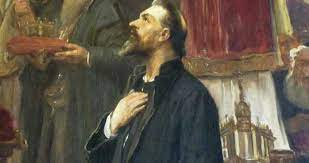Burning at the stake was a method of execution used in Babylonia and ancient Israel. It was later adopted in Europe and North America. This was the mode of execution used to punish disbelievers and heretics. But do you know the story of Jan Hus, and why he was burned at the stake?
Jan Hus, who lived a century before Martin Luther, chastised the Catholic Church for selling indulgences and church positions. He was summoned to the Council of Constance, arrested, charged with heresy, and burned at the stake on July 6, 1415.
Who is Jan Hus?
Jan Hus was one of the most important 15th-century Czech religious reformists whose work bridged the medieval and reformation periods and foreshadowed the Lutheran Reformation by over a century.
He was embroiled in the bitter Western Schism controversy over his entire career, and he was convicted of heresy at the Council of Constance and burned at the stake. (Source: Britannica)
The Trial and Execution of Jan Hus
Sigismund of Hungary, the so-called King of the Romans and heir to the Bohemian throne, was eager to end religious strife within the Church. He arranged for a general council to meet in November 1414 in Konstanz, Germany, on Lake Constance, just across the border from Switzerland.
The Council of Constance was the Catholic Church’s 16th recognized ecumenical council. Hus eagerly agreed to travel to Konstanz in exchange for Sigismund’s promise of safe conduct.
Hus was arrested and imprisoned in the Dominican monastery dungeon just a few weeks after arriving in Konstanz. In December, he was subjected to a formal investigation but was not allowed an advocate for his defense. Hus was taken to the castle of the Archbishop of Konstanz and held there for 73 days, separated from his friends, chained day and night, malnourished, and ill.
His trial began on June 5, 1415, and he was transferred to a Franciscan monastery. He stated that if his faults were verified in the Bible, he would retract but otherwise defended his reforming objections against the Church.
The condemnation took place in the presence of the Council assembly at the Cathedral on July 6, 1415. Hus was led inside the church after the High Mass and Liturgy. He argued, saying that even at this hour, all he wanted was to be convinced by Scripture. He fell on his knees and begged God to forgive all of his foes.
He knelt at the execution site, put his palms out, and prayed aloud. The executioner stripped him of his clothes, tied his hands behind his back, and attached a chain around his neck to a post around which wood and straw had been piled up to cover him from head to toe. Hus refused to recant at the last possible moment to save his own life.
God is my witness that the things charged against me I never preached. In the same truth of the Gospel which I have written, taught, and preached, drawing upon the sayings and positions of the holy doctors, I am ready to die today.
Jan Hus
Hus’ ashes were scattered in the Rhine River. (Source: Peoples World)
